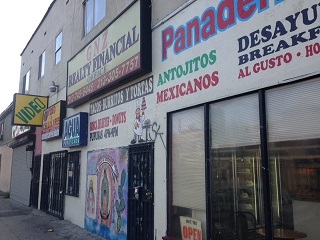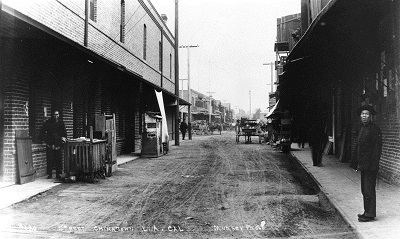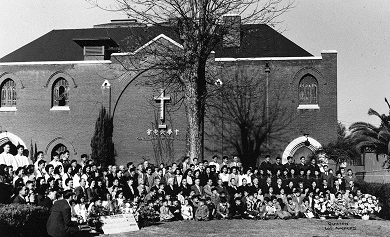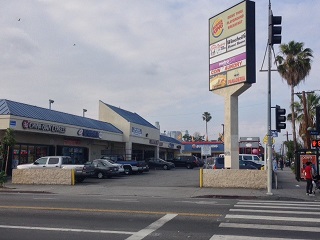If you drive through the neighborhood around the intersection of Adams and San Pedro Street today, you will see a strip mall and on the opposite corner a clothing store. Everywhere you look, there are businesses with signs in Spanish, reflecting the predominantly Latino population. What you won’t find are many signs of the Chinese community that lived in the area between the 1930s and 1960s. If we take a look back at the history of this particular neighborhood, we learn much about the over-160 year history of the Chinese in Los Angeles.

Storefronts at Adams & San Pedro
The U.S. Census of 1850 lists two Chinese men living in Los Angeles: Alluce and Ah Fou, who were house servants in the home of Robert and Mary E. Haley.

1850 U.S. Census
The Chinese community grew during the 1860s and 1870s as many of the Chinese laborers recruited to work on the railroads migrated to Los Angeles once the tracks were completed. They settled in the area east of the Los Angeles Plaza. This small community (Old Chinatown) was an ethnic enclave where Chinese immigrants spoke the same language, shared a culture, and provided support for each other against the pervasive anti-Chinese sentiment of the day. The Chinese started businesses with low start-up costs in industries that did not compete with white Americans—laundries, restaurants, truck farming, and produce selling.

Old Chinatown circa 1900. The unpaved road is lined with street vendors and horse drawn wagons.
The migration out of Old Chinatown began with the establishment of the City Market in 1909. By this time, Chinese dominated the produce industry in the city. Louie Quan, savvy in business and fluent in English, built the new wholesale produce mart at 9th and San Pedro Streets. City Market provided jobs and economic opportunities outside of Old Chinatown. The exodus accelerated in the thirties when Old Chinatown was torn down for the construction of Union Station.
Due to the lack of residential housing in the immediate vicinity of City Market and the restrictive housing covenants in most areas of the city, the adjacent neighborhood near the intersection of East Adams and San Pedro Street became home to Chinese Americans looking for single family houses. Unlike Old Chinatown, East Adams was a racially mixed neighborhood. Chinese Americans lived next door to African Americans, Armenians, and Latinos.
With the influx of Chinese families, Chinese American institutions sprung up in the area. The Chinese Presbyterian Church moved to 631 E. Adams in 1939 and was a social center for the community. The church operated a Chinese language school which Chinese children attended in the afternoons, after public school ended.

Chinese Presbyterian Church on East Adams
Several Chinese-owned businesses were also focal points of the community. CFO gas station was owned by five young Chinese men. CFO was an acronym for the last names of the owners: Abe, Howard and George Chin, Wesley Fong and Henry Ong. CFO was more than a corner gas station. Covering nearly a block, it had a long row of lifts, a tire store, and was a hangout for the local youth looking to "hop up" their cars.

Strip mall at former location of CFO gas station
Calvin Hai's father started the Kwong Hing Lung Chinese American grocery store in 1951 at the corner of Adams and San Pedro. Besides groceries, it offered good conversation and assistance to Chinese newly arrived from China.
After the war, the Chinese started to move out of East Adams. Soldiers came back from the war, went to college on the GI bill, got married, and started families. In 1948 the Supreme Court ruled racial real estate covenants to be unconstitutional and Chinese and other ethnic minorities were no longer confined to certain areas of the city.
Though no longer a Chinese American hub, East Adams was one of the first Chinese American suburbs in southern California, a forerunner to Monterey Park, San Gabriel, Alhambra, and other communities with large Chinese populations. With its shifting demographics, East Adams reflects the ever-changing dynamic of Los Angeles neighborhoods.